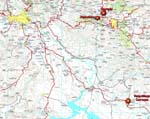 |
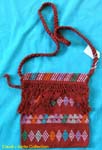 |
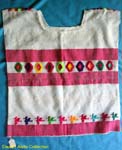 |
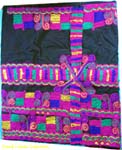 |
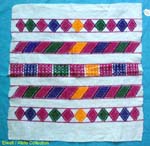 |
 |
 |
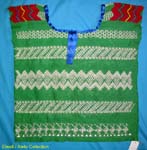 |
| We drove to Venustiano Carranza from Amatenango. The road was narrow, winding, and in poor condition. Leaving the cool, wet mountains, we arrived in a land of hot, dry plains where cattle ranching is the main economic activity. We saw a mountain rising from the plains in the distance. We could just make out a town on top of the mountain San Bartolome de los Llanos, AKA Venustiano Carranza. The road into town leaves the main highway and winds to the top of the mountain. Carranza is a large town that has all of the services of any modern Mexican community. The indigenous people of the town are Tzotzil speakers, but many non-Indians live in Carranza. We had heard that there was a textile coop in town, so we drove around the central plaza several times trying to find it. Nothing. "Plan B" was to find a woman wearing traditional clothing and ask her if she knew anyone who had textiles to sell. Just about everybody was wearing western clothes, but a few women were dressed in a modern version of the distinctive Carranza embroidered skirt. These knee-length skirts were fitted to their bodies and closed with zippers. The first woman we stopped graciously led us through winding streets to her aunt’s house on the edge of town. Tia Rosa invited us inside. When we told her we wished to purchase clothing, she took the top off a plastic 55-gallon garbage can and pulled out a plastic bag full of textiles. The first huipiles she showed us were the kind that are made for the commercial market. (The white huipil with horizontal pink bands is of this kind) When we said that we´d like to buy the type of huipil that they wear, she produced a green and white one-web huipil with the traditional ribbon around the neck and zigzag embroidery on the shoulders. Now that we had the huipil, Tia Rosa told us we needed the traditional skirt. She had Karen step into the wide indigo tube, and showed us how the skirt is doubled and cleverly folded so that it holds itself up without a belt. The Carranza skirt is one of the more distinctive indigenous skirts in Mexico. The areas where the pieces of fabric are joined are embroidered in wide strips of pink, blue, green, and yellow thread. The skirt is then embellished with more embroidery in the same colors. The Carranza traje is very similar to the traditional Zoque costume of the Tuxtla Gtz region, and quite unlike the Tzotzil costumes of the San Cristobal area. When the Cordrys visited Carranza, they noted that Zoque people from Tuxtla were traveling to Carranza to buy brocaded fabrics. Before leaving, we also purchased a “corte” for a huipil. This rectangular brocaded fabric is an unfinished one-web huipil. The neck has not yet been opened, and the sides have not been sewed together. We also bought a small panuelo. Tia Rosa showed us how it is worn on the shoulder or atop the head. We saw no men wearing the traditional Carranza men’s costume of long-sleeved white shirt and voluminous ankle-length white pants. These pieces are still made, but only worn on special occasions today. The beautiful red and white shoulder cloths are still woven. We saw several on sale in San Cristobal shops, but they cost hundreds of dollars. |
|
Home - The Collection - Favorite Photos- Bob's Top 10 - Textile Patterns - The Villages - Participate
For more information or comments please contact me at: info@mexicantextiles.com © 2005 Bob Freund All Rights Reserved |